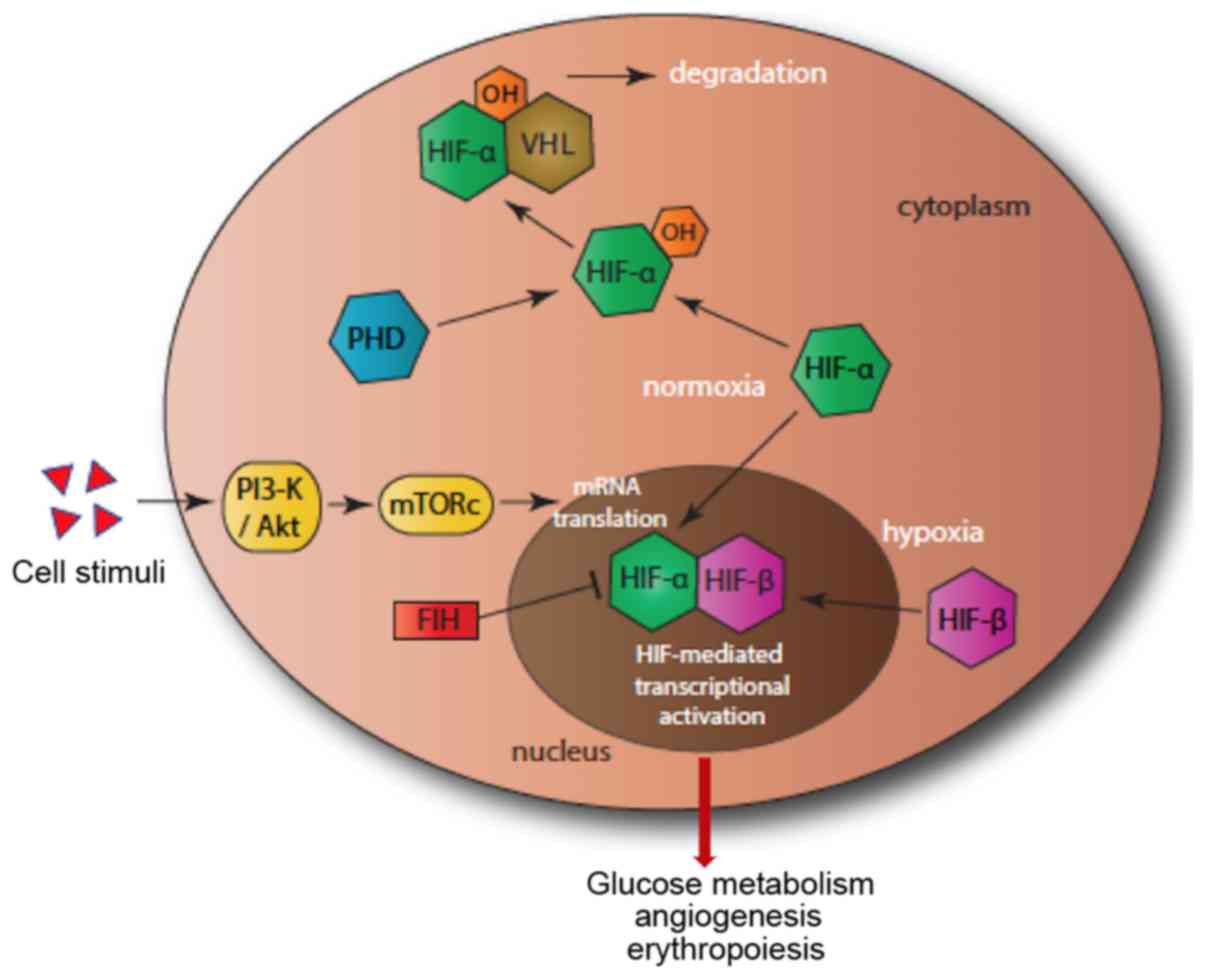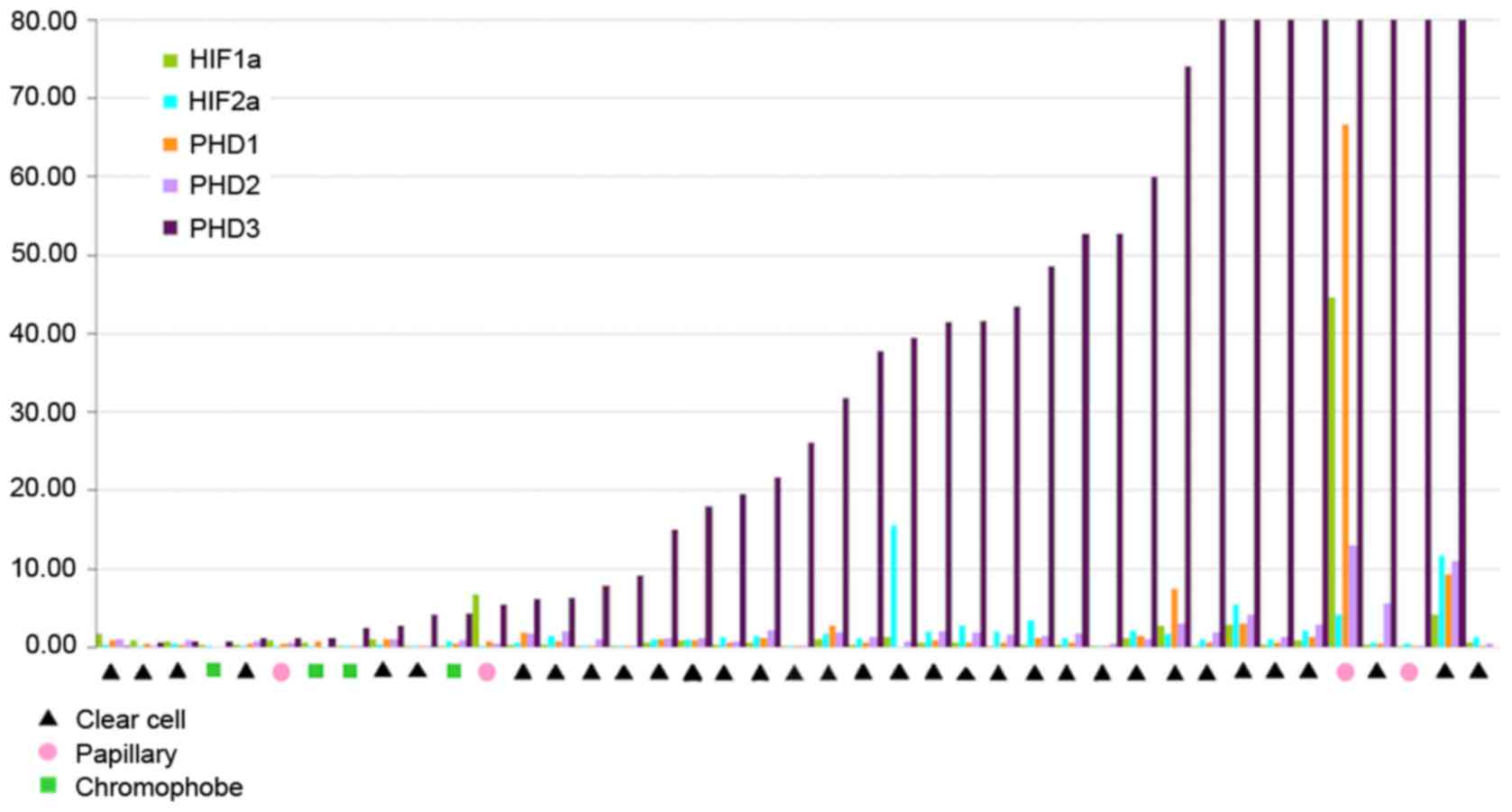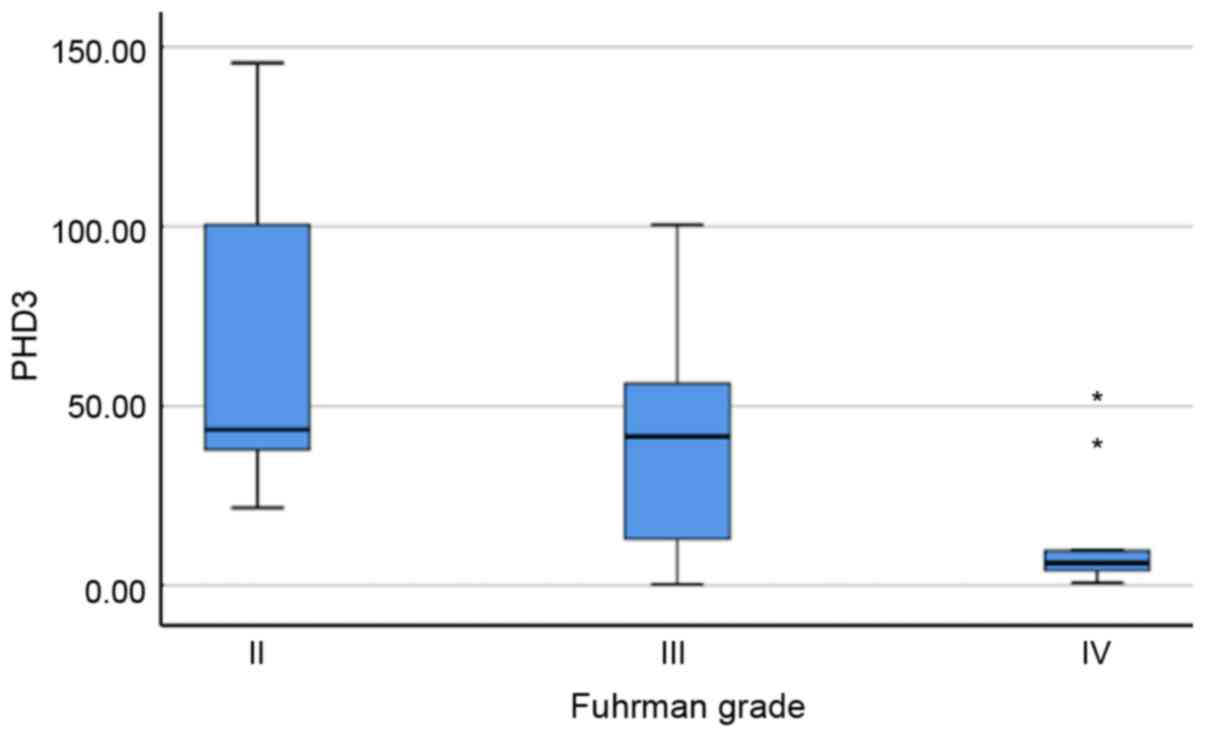|
1
|
Jemal A, Siegel R, Xu J and Ward E: Cancer
statistics, 2010. CA Cancer J Clin. 60:277–300. 2010.PubMed/NCBI View Article : Google Scholar
|
|
2
|
Sun M, Marconi L, Eisen T, Escudier B,
Giles RH, Haas NB, Harshman LC, Quinn DI, Larkin J, Pal SK, et al:
Adjuvant vascular endothelial growth factor-targeted therapy in
renal cell carcinoma: A systematic review and pooled analysis. Eur
Urol. 74:611–620. 2018.PubMed/NCBI View Article : Google Scholar
|
|
3
|
Kovacs G, Akhtar M, Beckwith BJ, Bugert P,
Cooper CS, Delahunt B, Eble JN, Fleming S, Ljungberg B, Medeiros
LJ, et al: The Heidelberg classification of renal cell tumours. J
Pathol. 183:131–133. 1997.PubMed/NCBI View Article : Google Scholar
|
|
4
|
Lane BR and Kattan MW: Prognostic models
and algorithms in renal cell carcinoma. Urol Clin North Am.
35:613–625, vii. 2008.PubMed/NCBI View Article : Google Scholar
|
|
5
|
Kimbro KS and Simons JW: Hypoxia-inducible
factor-1 in human breast and prostate cancer. Endocr Relat Cancer.
13:739–749. 2006.PubMed/NCBI View Article : Google Scholar
|
|
6
|
Vaupel P, Kelleher DK and Höckel M: Oxygen
status of malignant tumors: Pathogenesis of hypoxia and
significance for tumor therapy. Semin Oncol. 28 (Suppl 8):29–35.
2001.PubMed/NCBI View Article : Google Scholar
|
|
7
|
Maxwell PH, Wiesener MS, Chang GW,
Clifford SC, Vaux EC, Cockman ME, Wykoff CC, Pugh CW, Maher ER and
Ratcliffe PJ: The tumour suppressor protein VHL targets
hypoxia-inducible factors for oxygen-dependent proteolysis. Nature.
399:271–275. 1999.PubMed/NCBI View
Article : Google Scholar
|
|
8
|
Mandriota SJ, Turner KJ, Davies DR, Murray
PG, Morgan NV, Sowter HM, Wykoff CC, Maher ER, Harris AL, Ratcliffe
PJ and Maxwell PH: HIF activation identifies early lesions in VHL
kidneys: Evidence for site-specific tumor suppressor function in
the nephron. Cancer Cell. 1:459–468. 2002.PubMed/NCBI View Article : Google Scholar
|
|
9
|
De Luise M, Girolimetti G, Okere B,
Porcelli AM, Kurelac I and Gasparre G: Molecular and metabolic
features of oncocytomas: Seeking the blueprints of indolent
cancers. Biochim Biophys Acta Bioenerg. 1858:591–601.
2017.PubMed/NCBI View Article : Google Scholar
|
|
10
|
Gerard GF, D'Alessio JM, Kotewicz ML and
Noon MC: Influence on stability in Escherichia coli of the
carboxy-terminal structure of cloned Moloney murine leukemia virus
reverse transcriptase. DNA. 5:271–279. 1986.PubMed/NCBI View Article : Google Scholar
|
|
11
|
Kotewicz ML, D'Alessio JM, Driftmier KM,
Blodgett KP and Gerard GF: Cloning and overexpression of Moloney
murine leukemia virus reverse transcriptase in escherichia coli.
Gene. 35:249–258. 1985.PubMed/NCBI View Article : Google Scholar
|
|
12
|
Marathe SV and McEwen JE: Vectors with the
gus reporter gene for identifying and quantitating promoter regions
in Saccharomyces cerevisiae. Gene. 154:105–107. 1995.PubMed/NCBI View Article : Google Scholar
|
|
13
|
Schmittgen TD and Livak KJ: Analyzing
real-time PCR data by the comparative C(T) method. Nat Protoc.
3:1101–1108. 2008.PubMed/NCBI View Article : Google Scholar
|
|
14
|
Gourvas V, Sifakis S, Dalpa E, Soulitzis
N, Koukoura O and Spandidos DA: Reduced placental prolyl
hydroxylase 3 mRNA expression in pregnancies affected by fetal
growth restriction. BJOG. 117:1635–1642. 2010.PubMed/NCBI View Article : Google Scholar
|
|
15
|
Aprelikova O, Chandramouli GV, Wood M,
Vasselli JR, Riss J, Maranchie JK, Linehan WM and Barrett JC:
Regulation of HIF prolyl hydroxylases by hypoxia-inducible factors.
J Cell Biochem. 92:491–501. 2004.PubMed/NCBI View Article : Google Scholar
|
|
16
|
Rantanen K, Pursiheimo JP, Hogel H,
Miikkulainen P, Sundstrom J and Jaakkola PM: p62/SQSTM1 regulates
cellular oxygen sensing by attenuating PHD3 activity through
aggregate sequestration and enhanced degradation. J Cell Sci.
126:1144–1154. 2013.PubMed/NCBI View Article : Google Scholar
|
|
17
|
Jaakkola PM and Rantanen K: The
regulation, localization, and functions of oxygen-sensing prolyl
hydroxylase PHD3. Biol Chem. 394:449–457. 2013.PubMed/NCBI View Article : Google Scholar
|
|
18
|
Högel H, Miikkulainen P, Bino L and
Jaakkola PM: Hypoxia inducible prolyl hydroxylase PHD3 maintains
carcinoma cell growth by decreasing the stability of p27. Mol
Cancer. 14(143)2015.PubMed/NCBI View Article : Google Scholar
|
|
19
|
Miikkulainen P, Hogel H, Rantanen K, Suomi
T, Kouvonen P, Elo LL and Jaakkola PM: HIF prolyl hydroxylase PHD3
regulates translational machinery and glucose metabolism in clear
cell renal cell carcinoma. Cancer Metab. 5(5)2017.PubMed/NCBI View Article : Google Scholar
|
|
20
|
Sato E, Torigoe T, Hirohashi Y, Kitamura
H, Tanaka T, Honma I, Asanuma H, Harada K, Takasu H, Masumori N, et
al: Identification of an immunogenic CTL epitope of HIFPH3 for
immunotherapy of renal cell carcinoma. Clin Cancer Res.
14:6916–6923. 2008.PubMed/NCBI View Article : Google Scholar
|
|
21
|
Tanaka T, Kitamura H, Torigoe T, Hirohashi
Y, Sato E, Masumori N, Sato N and Tsukamoto T: Autoantibody against
hypoxia-inducible factor prolyl hydroxylase-3 is a potential
serological marker for renal cell carcinoma. J Cancer Res Clin
Oncol. 137:789–794. 2011.PubMed/NCBI View Article : Google Scholar
|
|
22
|
Appelhoff RJ, Tian YM, Raval RR, Turley H,
Harris AL, Pugh CW, Ratcliffe PJ and Gleadle JM: Differential
function of the prolyl hydroxylases PHD1, PHD2, and PHD3 in the
regulation of hypoxia-inducible factor. J Biol Chem.
279:38458–38465. 2004.PubMed/NCBI View Article : Google Scholar
|
|
23
|
Tanaka T, Torigoe T, Hirohashi Y, Sato E,
Honma I, Kitamura H, Masumori N, Tsukamoto T and Sato N:
Hypoxia-inducible factor (HIF)-independent expression mechanism and
novel function of HIF prolyl hydroxylase-3 in renal cell carcinoma.
J Cancer Res Clin Oncol. 140:503–513. 2014.PubMed/NCBI View Article : Google Scholar
|
|
24
|
Kroeze SG, Vermaat JS, van Brussel A, van
Melick HH, Voest EE, Jonges TG, van Diest PJ, Hinrichs J, Bosch JL
and Jans JJ: Expression of nuclear FIH independently predicts
overall survival of clear cell renal cell carcinoma patients. Eur J
Cancer. 46:3375–3382. 2010.PubMed/NCBI View Article : Google Scholar
|
|
25
|
Salama R, Masson N, Simpson P, Sciesielski
LK, Sun M, Tian YM, Ratcliffe PJ and Mole DR: Heterogeneous effects
of direct hypoxia pathway activation in kidney cancer. PLoS One.
10(e0134645)2015.PubMed/NCBI View Article : Google Scholar
|
|
26
|
Chen W, Hill H, Christie A, Kim MS,
Holloman E, Pavia-Jimenez A, Homayoun F, Ma Y, Patel N, Yell P, et
al: Targeting renal cell carcinoma with a HIF-2 antagonist. Nature.
539:112–117. 2016.PubMed/NCBI View Article : Google Scholar
|
|
27
|
Wallace EM, Rizzi JP, Han G, When PM, Cao
Z, Du X, Cheng T, Czerwinski RM, Dixon DD, Goggin BS, et al: A
small-molecule antagonist of HIF2α is efficacious in preclinical
models of renal cell carcinoma. Cancer Res. 76:5491–5500.
2016.PubMed/NCBI View Article : Google Scholar
|

















